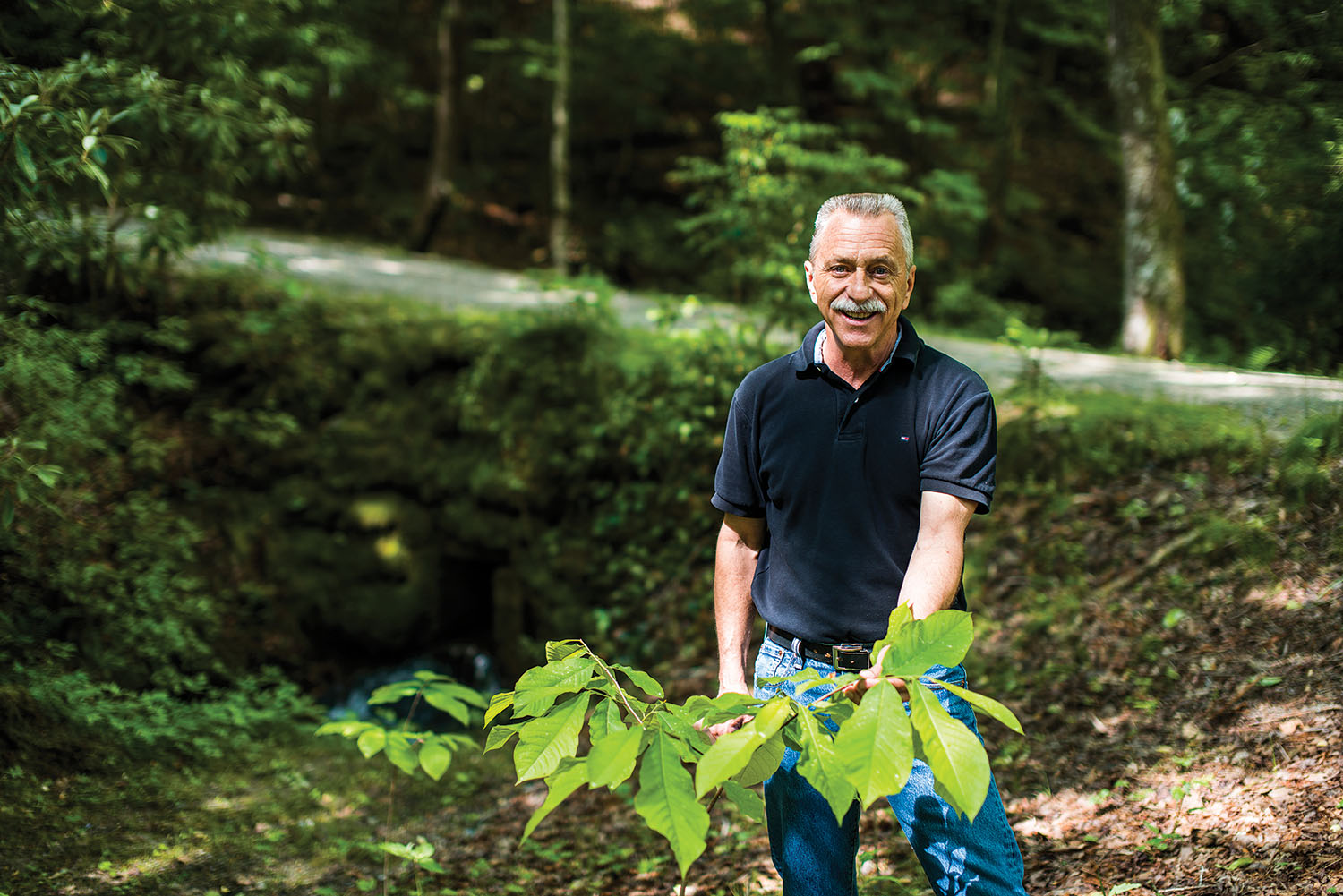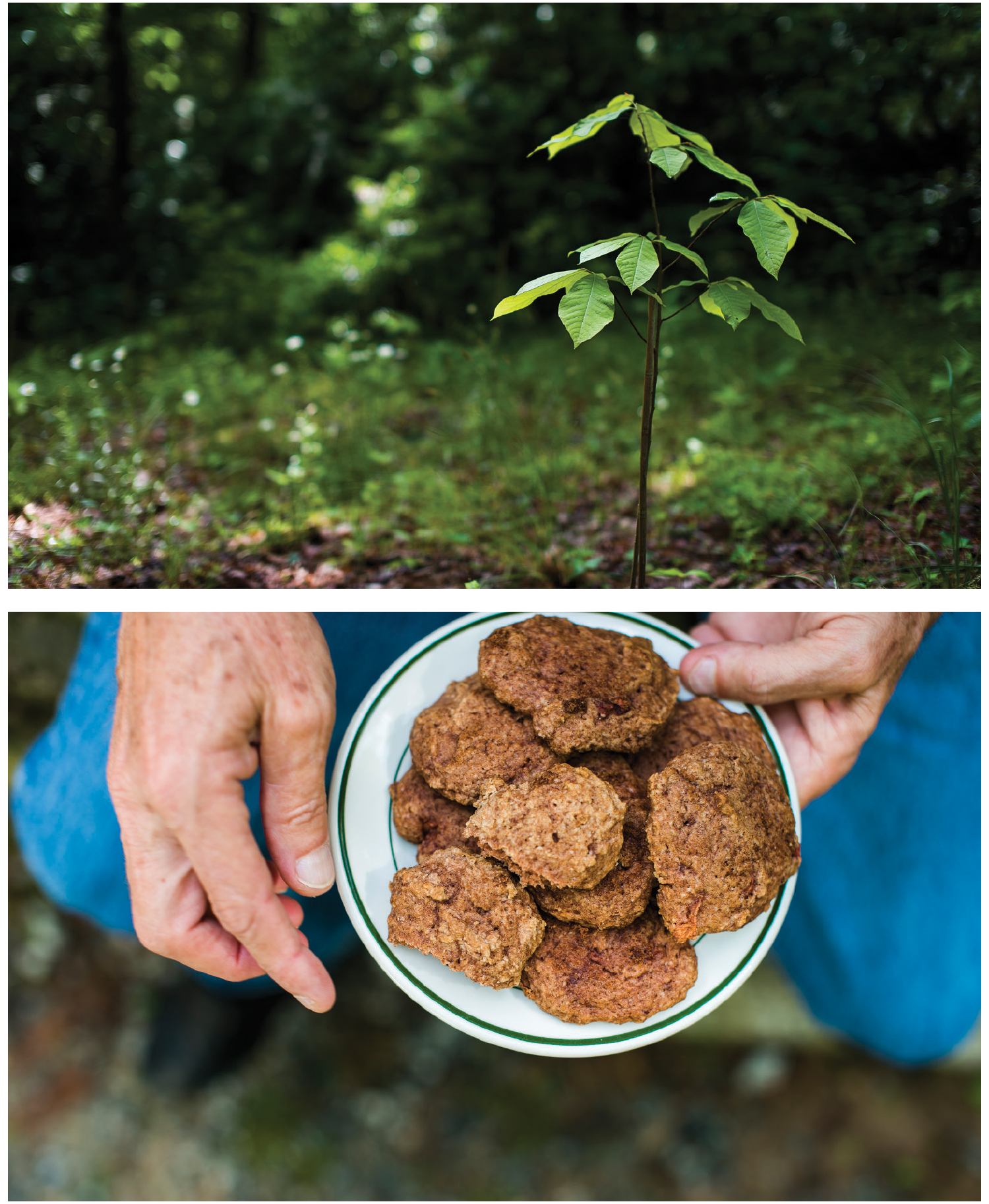
Photo by Karin Strickland
Pawpaws do funny things to people. So says Kim Bailey, a local pawpaw farmer and environmental educator. Bailey, who owns Milkweed Meadows farm in the Fruitland area of Henderson County, is tending to a crop of 85 young trees. Her love of the pawpaw bloomed because of the tree’s unique relationship with the zebra swallowtail butterfly. The swallowtail only lays its eggs on pawpaw leaves, and the caterpillars feed on it. So Bailey used pawpaws in pollinator gardens long before she considered them as a crop.
“I was intending to plant them just for the butterflies. And somewhere along the line, I got to taste the fruit of one.” The experience, she says, was like “crème brûlée on a tree.” She soon planted a lot more.
“One thing that’s really nice about growing pawpaw trees is that not a lot of insects eat them,” she notes. Organic and permaculture farmers also like the tree because It’s not as intensive as cultivating apples and peaches. “It’s native and is adapted to grow here, so it doesn’t need as much help from the farmer,” explains Bailey.
Craig Mauney, a Henderson County extension agent, is a lifelong pawpaw evangelist who has one pawpaw farm in the Piedmont and two acres of trees in his new orchard in the area. He’s also in love with the fruit for its custardy, distinctive tropical taste, and for its nutritional and medicinal properties, too.
Mauney and Bailey both wax poetic about the delicate wine-colored blossoms that unfurl in May, just as the leaves begin to open and are pollinated by beetles, flies, ladybugs, and other insects. In fact, some growers even hang dead fish in their orchards to draw them to the blooms. By August, the limbs are often bent under the weight of the fruit — up to a pound per pawpaw.
But don’t ask locals where they find their pawpaws. For most foragers, that intel is carefully guarded. And the fruit is treated as the highly perishable treasure it is. Pawpaws may pop up briefly at local markets and stands; otherwise, the best bet may be to turn to pawpaw pages on social media. Cultivating one’s own pawpaws is also a growing trend.

Photo by Karin Strickland
In August, Mauney will host a workshop on the subject at Bullington Gardens. Here he offers some down-to-earth advice.
How did you learn about pawpaws?
Craig Mauney: I ate them as a child in Brasstown [on the North Carolina/Georgia border]. As I grew, I developed an interest in unusual edibles and started finding them in native populations. About 35 years ago, I started promoting pawpaws to anyone who would listen.
What’s your goal with your orchard?
To retire and be a pawpaw-pulp supplier. I’ve got three mini orchards. And I’m hoping to have two acres of pawpaws in the next few years. There’s a big deficit of pulp in our region and people want it really badly. I think there are nine growers in the area now.
Where do they grow in the wild?
All over North America, primarily in the Appalachian range and the Ohio Valley. Around here, there are many in southern Henderson County. Most are seen in moist coves, often near rivers, especially in areas that haven’t been logged.
Can you offer advice for foragers?
The problem with foraging is that once you find your tree, you have to have a way to get up to the fruit when it begins to soften, but before it falls. Once pawpaws fall to the ground, opossums, deer, raccoons, and bears just eat them up. So find your tree and keep track of it. Find it in April or May to look for flowers so you can tell which trees are likely to fruit. Pick fruit when it’s just soft to the touch.
How easy are they to grow?
Very easy, because they’re native. And they grow in anything from deep shade to full sun. But there’s an establishment period of about five years that can be challenging because they’re tap-rooted.
Any cultivation tips?
The biggest problem with pawpaws is that you need two individual pawpaws grown from different seeds to have cross-pollination. (Mauney notes that because the trees send out runners, the “pawpaw patch” of the traditional Appalachian folksong may actually be a single tree.)
I’ve read that pawpaws spoil easily. Do you have any advice for preserving them?
That’s the biggest problem with growing pawpaws commercially. They are like a banana in that once they start, they continue to ripen quickly. So you have to harvest them and take the pulp out of the fruit and freeze it. That’s how we sell it. You maybe have a three- to five-day shelf life on a pawpaw otherwise. And they ripen daily, so you have to pulp out maybe ten pawpaws at a time.
Do you have any interesting recipes?
Oh, yes. I make the best trifle in the nation. I do a ham spread. Some of my recipes are published in the national pawpaw cookbook. I do cookies that are out of this world.
On Saturday, August 18, Bullington Gardens (95 Upper Red Oak Trail, Hendersonville) hosts an event, Celebrating the Pawpaw, from 9am-noon. Craig Mauney discusses propagation, shares recipes, and holds a Q&A period, followed by tastings. $25. To register, visit bullingtongardens.org or call 828-698-6104.
